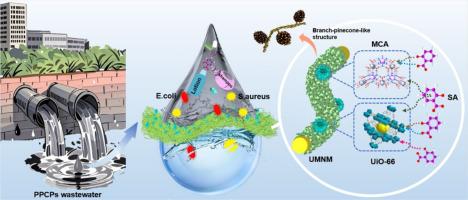一种新型柔性枝-松果纳米结构UiO-66-MCA复合纳米纤维膜,具有抑菌性能,可有效去除水杨酸
IF 12.4
1区 环境科学与生态学
Q1 ENGINEERING, ENVIRONMENTAL
引用次数: 0
摘要
药品和个人护理产品(PPCPs)由于其广泛存在,持久性和潜在的破坏微生物生态系统而构成重大的生态风险。传统吸附剂往往存在吸附能力有限、细菌污染、可重复使用性差等问题,需要开发先进的多功能材料。在此,我们提出了一种新的柔性枝-松果纳米结构的UiO-66-MCA复合纳米纤维膜(UMNM),该膜通过静电纺丝和自组装相结合的工艺设计,在UiO-66包裹的纳米纤维上生长出松果状的MCA结构。这种独特的分层结构协同增强了PPCPs的吸附和抗菌性能。UMNM对水杨酸(SA)表现出优异的吸附性能,吸附量为154.21 mg/g,其动力学和等温线分别符合拟二阶和Freundlich模型。值得注意的是,该膜在复杂的废水条件下保持强劲的吸附,表现出优异的再生和抗干扰能力。在动态过滤试验中,UMNM从原污水中去除80.89%的SA,同时将化学需氧量(COD)从149.17 mg/L降至48.48 mg/L,达到废水排放标准。此外,UMNM对大肠杆菌(E. coli)的抑菌率为72.20%,对金黄色葡萄球菌(S. aureus)的抑菌率为84.58%,降低了生物污染风险。本研究提出了一种创新的MOFs-HOFs复合膜,该膜集多功能PPCPs去除,抑菌活性和实际废水适用性于一体,为新兴水生污染物提供了突破性的解决方案。本文章由计算机程序翻译,如有差异,请以英文原文为准。

A novel flexible branch-pinecone nanostructured UiO-66-MCA composite nanofiber membrane with bacteriostatic property for effective removal of salicylic acid
Pharmaceuticals and personal care products (PPCPs) pose significant ecological risks due to their widespread occurrence, persistence, and potential to disrupt microbial ecosystems. Conventional adsorbents often suffer from limited adsorption capacity, bacterial fouling, and poor reusability, necessitating the development of advanced multifunctional materials. Herein, we present a novel flexible branch-pinecone nanostructured UiO-66-MCA composite nanofiber membrane (UMNM) engineered through a combination of electrospinning and self-assembly process, where pinecone-like MCA structures grow on UiO-66 wrapped nanofibers. This distinctive hierarchical architecture synergistically enhances PPCPs adsorption and antibacterial properties. The UMNM demonstrates exceptional adsorption performance for salicylic acid (SA), achieving a capacity of 154.21 mg/g, with kinetics and isotherms following the pseudo-second-order and Freundlich models, respectively. Notably, the membrane maintains robust adsorption under complex wastewater conditions, exhibiting excellent regeneration and anti-interference capabilities. In dynamic filtration tests, the UMNM removes 80.89% of SA from raw sewage while reducing chemical oxygen demand (COD) from 149.17 mg/L to 48.48 mg/L, meeting wastewater discharge standards. Furthermore, the UMNM achieves bacteriostatic rates of 72.20% against Escherichia coli (E. coli) and 84.58% against Staphylococcus aureus (S. aureus), mitigating biofouling risks. This study presents an innovative MOFs-HOFs composite membrane that integrates multifunctional PPCPs removal, bacteriostatic activity, and real-world wastewater applicability, offering a breakthrough solution for emerging aquatic contaminants.
求助全文
通过发布文献求助,成功后即可免费获取论文全文。
去求助
来源期刊

Water Research
环境科学-工程:环境
CiteScore
20.80
自引率
9.40%
发文量
1307
审稿时长
38 days
期刊介绍:
Water Research, along with its open access companion journal Water Research X, serves as a platform for publishing original research papers covering various aspects of the science and technology related to the anthropogenic water cycle, water quality, and its management worldwide. The audience targeted by the journal comprises biologists, chemical engineers, chemists, civil engineers, environmental engineers, limnologists, and microbiologists. The scope of the journal include:
•Treatment processes for water and wastewaters (municipal, agricultural, industrial, and on-site treatment), including resource recovery and residuals management;
•Urban hydrology including sewer systems, stormwater management, and green infrastructure;
•Drinking water treatment and distribution;
•Potable and non-potable water reuse;
•Sanitation, public health, and risk assessment;
•Anaerobic digestion, solid and hazardous waste management, including source characterization and the effects and control of leachates and gaseous emissions;
•Contaminants (chemical, microbial, anthropogenic particles such as nanoparticles or microplastics) and related water quality sensing, monitoring, fate, and assessment;
•Anthropogenic impacts on inland, tidal, coastal and urban waters, focusing on surface and ground waters, and point and non-point sources of pollution;
•Environmental restoration, linked to surface water, groundwater and groundwater remediation;
•Analysis of the interfaces between sediments and water, and between water and atmosphere, focusing specifically on anthropogenic impacts;
•Mathematical modelling, systems analysis, machine learning, and beneficial use of big data related to the anthropogenic water cycle;
•Socio-economic, policy, and regulations studies.
 求助内容:
求助内容: 应助结果提醒方式:
应助结果提醒方式:


